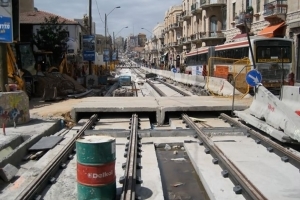Jerusalem’s big dig nearing end
Jerusalem’s light-rail project is on its way to completion but there are still delays.
click here for original post
By Amihai Zippor
JERUSALEM (JTA) — When Israel launched its effort in the 1990s to install the country’s first light rail system in Jerusalem, it was to be the impetus for a broader revitalization effort aimed at replacing Turkish-era infrastructure, easing congestion and cleaning up pollution in the capital city.
It also was supposed to be a model for other proposed light-rail systems in the country, such as Tel Aviv.
But building errors, bureaucratic delays and poor management have clouded the vision of Jerusalem as a model for a cleaner, more user-friendly transportation system.
Seven years after a consortium called CityPass won the contract to build the system, the tracks still aren’t finished and costs have soared. The city’s main downtown artery, Jaffa Street, is virtually shut down, and area shopkeepers say the construction has hurt their businesses as residents and tourists have steered clear of the area.
“It’s super tight and I hate going down there,” Oshra Atia, a Los Angeles native and mother of two who lives in the Jerusalem neighborhood of Nachlaot, said of downtown. “You just can’t walk downtown with a stroller.”
But with the project about a year away from becoming operational, Jerusalem’s residents finally are on the verge of reaping the benefits from what for the last couple of years has been a major disruption.
What isn’t clear is whether area businesses, some of which have been around for nearly a half-century, will survive long enough to see those benefits. Some local merchants say the construction headache has brought them to the verge of bankruptcy, with some stores reporting income declines of up to 90 percent.
“It affects our business considerably,” Barry Sibul of the Village Green restaurant said of the construction. “It’s very hard to get here, the walkways are hard to walk on and uncomfortable to negotiate, and there’s a lot of noise and a lot of dirt.”
Jerusalem’s municipality provides aid to local businesses, including loans of up to $35,000. Some shopkeepers have complained that a cumbersome approval process has made the loans difficult to get.
Shmuel Elgrabli, a government spokesman for the light rail project, said the temporary disruption on Jaffa Street will pay off in the long run. He also noted that the project includes invaluable updates to all water, electricity and communication lines in downtown Jerusalem.
“Before we started the project, all of Jaffa Street, which cuts through the center of town, was filled with buses like a train from one end to the other. The city was a mess,” Elgrabli said. “Everything we are trying to do is the solution, not the problem.”
Most Jerusalemites, he said, “want to see a renewed city, a city like in Europe, where all of Jaffa Street will be pedestrian. Places like Strasburg and Paris are examples of how new transportation systems sparked urban renewal.”
In the city’s vision, the dollar stores now on Jaffa Street will be replaced by higher-end retailers and restaurants.
Line 1 of the light rail system — the red line — is slated to run from the Pisgat Ze’ev neighborhood in northeast Jerusalem through the center of town, then southwest to Mount Herzl. Government surveys taken prior to the construction showed that about 400,000 people would be served by the route.
With 12 of the 18 miles of track laid and four of 24 stations built, Jerusalem already has planned extensions to the neighborhood of Neve Ya’akov and Hadassah Hospital at Ein Karem.
Jerusalem’s master plan proposes a total of five lines, but aside from the red line only one other — the blue — has been approved for work. The roadwork on the blue route has been completed, but its conversion to light rail is dependent on future usage, which is expected to rise in the next few years. The line would run from Hebron Road in southern Jerusalem to Ramot in northern Jerusalem.
This stage of the project will cost more than $1 billion, according to government estimates. A recent report by state Comptroller Micha Lindenstrauss found government spending 160 percent above the original forecasted budget.
Originally supposed to be completed by January 2009, as of now the first trains are expected to run in September 2010.
But with CityPass asking for a nine-month extension, which the city thus far has refused to grant, many businesses in the affected areas are having trouble seeing light at the end of the tunnel.
“We know we have to be patient, and eventually it’s going to be cleaned up and look very pretty,” Sibul said, “but I’m not sure it’s going to bring that many more people.”



